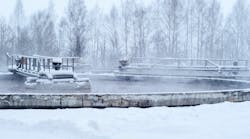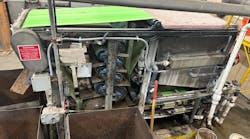The City of Springfield, Mass., currently uses a contract composting facility, which is located at the 65 MGD Bondi Island Wastewater Treatment Plant to dispose of their solid waste.
The composting facility requires a feed of 40-45% solid materials to effectively operate the composting process. The treatment plant, which has primary settling and a conventional waste-activated secondary process with no digestion, produces 20-23% cake solids from their belt filter presses.
In the spring of 2002, the City of Springfield installed a Komline-Sanderson Biosolids Drying Facility. The drying facility consists of a wet cake storage silo, progressing cavity sludge transfer pumps, and a Komline-Sanderson 3,000 sq. ft. indirectly heated stainless steel dryer.
In addition, a post-mix conveying system was incorporated into the application to mix and convey dewatered belt press cake and dried biosolids, to have a final consistency of 40-45% solids at the composting facility.
Not to mention, the installation also includes a thermal fluid boiler heated by natural gas and a particulate, as well as an odor control facility to minimize odor from the drying process.
Facility operation
The drying facility operates 24 hours a day, seven days a week with minimal operator attention.
One operator is in charge of both the drying facility and the belt press de-watering facility per shift. The Komline-Sanderson indirectly heated dryer produces a dried product having 95% solids, which could be disposed of as a Class A, exceptional quality material.
However, the treatment plant mixes the dried biosolids with the 20-23% solid belt press sludge before sending the 40-45% mixed material to the composter.
The malodorous off-gases from the dryer pass through a water spray condenser where the water vapor is removed before the non-condensable gases are sent to a thermal oxidizer, which exists at the treatment plant to handle odors from the composting facility. The indirect dryer contributes less than 800 actual cubic feet per minute to the thermal oxidizer, which permitted the use of the existing odor control facility.
The City of Springfield values the reliability and low maintenance requirements of the Komline-Sanderson Biosolids Drying system as well as the size and minimal impact on the surrounding environment.
Odors and dust have been non-existent, which is especially important to the treatment plant, which is located near the downtown area of Springfield.
For more information, call Komline-Sanderson at
908/234-1000, or visit them online at www.komline.com.

